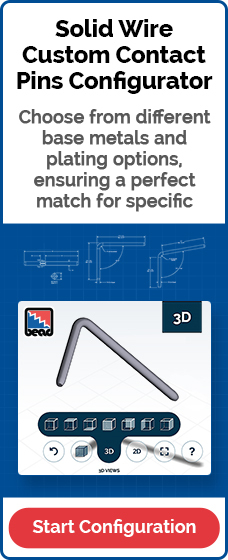Wires are considered the backbone of the modern information age. When someone uses the word "wire," they most commonly mean a flexible, cylinder-shaped piece of metal. They're probably talking about an item with a diameter that might range from a few millimeters to several centimeters.
The term "wire" can relate to electrical or mechanical use. Solid wire is used in many applications, and contact pins must be in place where there is solid wire. To learn more about solid wire contact pins, keep on reading this article.
What Is Solid Wire?
In comparison to the stranded wire, the solid metal core wire is a heavier, thicker product. It is perfect for outdoor applications where larger currents and more durability are needed.
This sturdy, affordable wire can withstand inclement weather and constant mobility. Things like vehicle controls and building structures use it to transport strong currents.
What are Electrical Contacts?
So, what exactly is an electrical contact, and why are they important? Reviewing common electrical connectors will help us understand more about why solid wire contact pins are useful.
First, information is communicated from a source to a destination through electrical impulses. When there is a lot of information, it is typically referred to as data.
In contrast, signals are used in applications like sensors or buttons to transmit fundamental information in binary form. As a result, signal contacts are often small as they don't require large current and voltage transfers.
On the other side, power contacts transmit voltage and current to operate parts and machinery. The contacts may be the same as signal contacts for applications needing low voltages.
However, larger or more energy-demanding applications will call for contacts with larger sizes. Up to a few dozen Amps of current can be delivered using industrial power contacts.
What Are Contact Pins?
 The pins and sockets broadly known as contacts are what create the electrical connection when they come into "contact."
The pins and sockets broadly known as contacts are what create the electrical connection when they come into "contact."
Some connections come with contacts, whereas others don't. The ones that come with contacts may or may not already be loaded. It actually depends on each product series, so it's crucial to know which connections are appropriate for your application.
Typically, solder cup contacts and PCB tail contacts are frequently preloaded, whereas crimp contacts are not.
Because contacts exist in a number of forms, sizes, and types, choosing the right contacts for your connections can be challenging.
Contacts come in a variety of forms, including stamped, machined (screw-machined), cold-formed including swaging, extrusion, and other contacts. Typically, smaller volume orders or power applications favor machined connections. They are often more appropriate for heavy use.
Stamped and formed contacts are more suited for high-volume production since they can be fed into automated crimping equipment.
What Are Precision Pin Tips?
Precision pin tips are helpful when it comes to connecting pin tips (e.g. male plugs) to receptacles (e.g. female contacts/wires).
When access is a problem, precision tips work to remove solder from through-hole junctions. The pin being desoldered should have an OD slightly larger than the ID of the tip.
The burrs and abrupt transitions on the surface of stamped or machined pin tips used by our rivals increase insertion and mating forces, damage mating surfaces, and produce conductive debris. All of Bead's round pins have spherical radius tips, and our "parabolically revolving" tip is available on square pins.

How to Choose Solid Wire Contact Pins
Choosing the right connector pins may be difficult.
Take your connector's and contacts' ability to carry current into account. The contacts in your connector will generate heat as electrical current flows through it, and the more contacts you have, the more heat the connector will experience.
Determining the connector layout is another crucial step. You must strike the appropriate balance between your electrical needs and the current carrying capability of the connection you are considering because adding more contacts within your connector will result in their producing more heat for contacts of the same size and capacity.
If you choose your layout first, it will define which contact sizes can fit in it. Each layout is also created for specific contact sizes.
All About Our Solid Wire Contact Pins
Precision pin tips made by Bead Electronics can cut insertion and mating forces by up to 35 percent. They are therefore optimal for all of your wire-wrapping, connection, and PCB applications.
There are many different configurations of square and round solid wire pins. Choose from straight, right angle, offset, stars, flanges, serrations, and barbs. Standard sizes are readily accessible off-the-shelf, and quick, low-cost tooling design and production of custom pins are also possible.
Even with unique pins, our high-speed precision production process offers our customers exceptional quality and competitive pricing.
The benefits of our solid wire pins include:
- tips with a smooth surface from our swaging process
- uniform pin length
- exact cutoff points
- many different configurations
- produced with Bead’s automated, scrap-less process
- fed through Bead’s automated, vision inspection system
The quality of your solid wires will only be as good as your contact pins. Our personalized pins work in a variety of contexts. What will you use them for?
Check Out Our Solid Wire Contact Pins Today
As you can see, solid wire contact pins have many uses. Now that you're aware of what contact pins are and how they are beneficial, you can use them today.
Our goal is to be a customer-focused business that gives creative solutions to clients, and that we outperform other suppliers. To get a quote on custom contact pins and more, click here!



